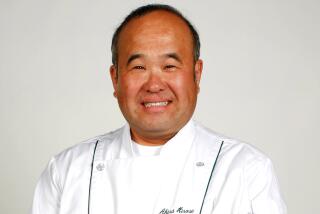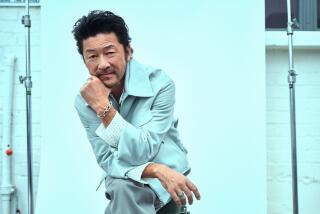COLUMN ONE : A Royal Uproar in Japan : A mysterious coronation rite for Akihito is pitting Shinto loyalists against foes of imperialism. The ceremony has fueled a violent church-state debate.
- Share via
ISE, Japan — Cross the pristine Isuzu River on a bridge made of bare cypress wood, walk down a broad pebble path through towering cryptomeria trees and behold the most sacred spot in the Japanese universe.
Here, behind a tall gate and fence, housed in a simple thatch-roof shrine, is the ancient Yata mirror, the embodiment of the Sun Goddess.
The mirror cannot be seen. Nor, for that matter, can very much of the main structure of the Grand Shrine of Ise. Yet worshipers on a recent rainy Saturday crowded before the gate clapping their hands and bowing in prayer to the invisible mirror, to Amaterasu - Omikami , as the Sun Goddess is known, and to the august line of emperors who claim descent from her mythical grandson.
This idyllic site has been the center of Japan’s tribal Shinto religion since the beginning of recorded history. This year, it is the focal point of a contentious, sometimes violent but mostly stifled debate over the nation’s modern identity and its cultural heritage.
In November, Emperor Akihito, 56, will partake in a mysterious nighttime ritual called the Daijo - sai, or “Great Food Offering Festival,” in primitive huts built on the grounds of the Imperial Palace in Tokyo.
He will face southwest, toward Ise, and commune with Amaterasu --one view is that he will engage in sexual intercourse with the goddess--in an enthronement ceremony that celebrates his divinity.
It will be an auspicious occasion for the nation, yet Akihito’s symbolic deification raises profound questions about the separation of church and state, and about the meaning of Japan’s constitutional monarchy.
Some prominent Japanese intellectuals are deeply disturbed that their government will pay for the ceremony, which marks Akihito’s formal accession nearly two years after the death of his father, Hirohito, known posthumously as Emperor Showa.
Government sponsorship not only violates the separation of religious and state affairs set forth in Japan’s postwar constitution, they warn, but it also legitimizes the myths surrounding the imperial institution.
These critics remember, painfully, how militarist Japan invaded and subjugated its Asian neighbors in the name of the emperor. They remember how the mystical symbols of the imperial office were used to mobilize loyal citizens and to persecute dissidents. And they ask whether adequate safeguards are now in place to prevent a recurrence of Japan’s dark days of totalitarianism.
From society’s right-wing fringe has come a passionate retort.
Scattered incidents of minor sabotage protested the recent visit of South Korean President Roh Tae Woo, who demanded--and received--an imperial apology for Japan’s oppressive colonization of the Korean Peninsula.
A rightist fanatic fired a pistol at point-blank range into the back of Mayor Hitoshi Motoshima of Nagasaki in January and later told police he wanted to punish the mayor for remarking in late 1988 that Emperor Showa was partly responsible for World War II. Motoshima recovered after the bullet passed within inches of his heart.
Other acts have specifically addressed the matter of enthronement. Late last year, one extremist cut off his finger and mailed it to Prime Minister Toshiki Kaifu to protest the fact that the government was allowing any debate at all on the issue.
The latest attack on free speech came in April, when two gunshots were fired into the home of Toru Yuge, president of Ferris Women’s College in Yokohama, shortly after he and three other Christian educators issued a statement questioning the legality of the Shinto enthronement rite.
The Daijo - sai , Yuge and his colleagues said, “shamelessly” transforms Akihito into a “living god,” even though Emperor Showa ostensibly renounced his divinity in a historic New Year’s radio address 44 years ago during the postwar Allied occupation.
“To hold such a ceremony . . . can only be feared as a movement toward a return to the imperial divine sovereignty, and away from the present system in which the emperor is defined as a symbol of the unity of the state,” the statement said. “It will inevitably invite the suspicions of those neighboring countries to which Japan, under the guise of imperial divine sovereignty, caused such tremendous suffering.”
Yuge narrowly escaped injury in the shooting at his home. The police have charged a right-wing activist in the attack. Handguns are banned in Japan and shootings are rare, giving the incident far more of a chilling effect than it might have elicited in, say, an American city.
Violence comes from the other end of the political spectrum as well, from far-left militants who revile the emperor as a vestige of Japan’s fascist past.
Radicals have been blamed for a string of vandalism, sabotage and homemade rocket attacks aimed at the imperial family. In January, projectiles were fired harmlessly into the residence of Prince Hitachi, the emperor’s younger brother. A minor roadside explosion marred Hirohito’s state funeral in February, 1989.
The anti-emperor guerrillas are bold enough that the Imperial Household Agency decided to grow the sacred rice for the Daijo - sai ceremony in secret locations, fearing an attempt to poison the crop or otherwise disrupt the exacting rituals of cultivation and harvest.
Even at Ise Shrine, security is a nagging concern. Video cameras are hidden in the trees and trained on the highly flammable wooden and straw structures “to guard against mischief,” as a shrine attendant put it.
Meanwhile, tension builds in the enthronement debate, as critics of the ceremony continue to receive threatening phone calls and letters, presumably from emperor-worshiping nationalists.
Yasuo Watanabe, president of Tokyo’s International Christian University, slumped in an armchair and grinned nervously as he talked about threats he has received since drafting the statement of conscience with Yuge.
“A strange kind of courage comes out at times like this,” said Watanabe, 63, a Presbyterian. “I figure it’s up to God how long I live.”
Watanabe produced a letter mailed to him in early May signed by a member of the Clear Wind Youth Academy, apparently a right-wing group. The text suggested the kind of atmosphere that prevailed during the era of militarism, when Shinto was the state religion and many Christians and intellectuals were persecuted for their beliefs.
“Urgent warning: You are advised henceforth to cease all anti-Japanese, treasonous, pro-Communist and anti-state activities,” said the letter, which was dated “Imperial Year 2650.” (State Shinto traces its calendar back to 660 BC, to the beginning of the first emperor’s legendary reign.)
Watanabe said: “We’re very worried about how the emperor might be used. The right-wing element remains very strong in Japanese society. Most people are of a conservative mind, and they can be easily swayed again. It could become dangerous.”
The vast majority of Japanese are caught between the extremes, vaguely supporting the idea of a constitutional monarchy and feeling a degree of respect for the Shinto trappings of the office.
But like other aspects of Shinto, Japan’s indigenous, nature-worshiping religion, the emperor is taken for granted. He may be the chief priest of the national tribe, but most people would scoff at the notion that he is an arahito - gami , or “god incarnate,” as his father and ancestors were held to be.
Consider the crowds that made the pilgrimage to Ise Shrine during the Golden Week holiday period from April 28 to May 6. Shrine officials counted 232,548 worshipers braving inclement weather in the nine-day period. Visitors cleansed their hands and mouths in the waters of the Isuzu River and prayed briskly, with somber expressions, at the various designated places in the inner and outer shrine compounds.
Their most notable activity, however, was posing for snapshots. Ise Shrine appears to be as much a tourist destination as an altar for the Sun Goddess, but what is truly in people’s hearts is a mystery.
“I think the majority of Japanese feel that the emperor is something holy,” said Hideaki Kase, a nationalistic writer, foreign affairs analyst and outspoken Shintoist. “I myself believe in the divinity of the emperor, but not in the Judeo-Christian sense. He’s a kami , a god with a small ‘g.’ ”
The government has appropriated the equivalent of about $53 million from the budget for Akihito’s enthronement, which involves two major ceremonies and a series of state banquets over a two-week period.
First, the emperor will formally announce his accession to the nation in a brief secular ceremony called the Sokui - no - rei , which is heavily influenced by ancient Chinese court ritual. Foreign and Japanese dignitaries will be invited to assemble Nov. 10 and shout, “ Banzai ,” or “Long life,” three times in Akihito’s honor.
Festive banquets are scheduled to follow until Nov. 14, after which Akihito will prepare himself to undertake the solemn Daijo - sai , an elaborate adaptation of the primitive harvest ritual the emperor routinely observes each autumn.
In the dead of the night of Nov. 22-23, inside darkened ceremonial huts--totally alone, for the most part--Akihito will feast on newly harvested rice and other foods and perform mysterious rites so ancient their meaning has long been lost or obscured.
Each of the twin huts, for example, will contain a primitive couch-like throne called a shinza . It is not clear whether the emperor will sit upon them, or whether they are intended to receive the Sun Goddess, or both. One scholarly interpretation is that the emperor will make love to the spirit of his ancestor. Another holds that he will enter her womb as a man and be reborn a deity.
Junko Iino, a spokeswoman for the Imperial Household Agency, said it “hasn’t been decided” whether Akihito will mount the throne-couches.
“There are a lot of things we don’t understand about the rites that have been handed down over the ages,” Iino said.
Yasuhiko Usui, a court ritualist, said the purpose of the thrones is to invite the goddess to join the ceremony. The emperor sits elsewhere, he said, and added: “Perhaps no one will be close enough to observe what’s actually happening.”
If it sounds like mystery by design, similar to the hidden mirror at Ise Shrine, then perhaps that is what Shinto is all about. But it should also be noted that few people alive today would remember what transpired 62 years ago, when Hirohito was the last emperor to commune with Amaterasu .
More to Read
Sign up for Essential California
The most important California stories and recommendations in your inbox every morning.
You may occasionally receive promotional content from the Los Angeles Times.













